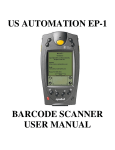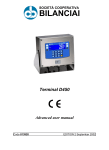Download Alcatel-Lucent 3D IPTV User's Manual
Transcript
3D IPTV A Potential Future (R)Evolution for Digital TV BELL LABS Research Project Digital television (IPTV), as we know it today is essentially little different from the former analog television. Nevertheless, the IPTV technology inherently offers a huge potential for growth in new services and personalization. technology will be able to bring the best quality for a certain application and at which bandwidth? Data size Context Fixed Viewpoint Free Viewpoint Less scene info More scene info Figure 2: Bandwidths of different 3D coding technologies Figure 1: Auto-stereoscopic 3D display Auto-stereoscopic 3D displays will be one of the technologies which will initiate a new era for digital television. This technology brings a new television experience, with a higher immersion of the viewer. In addition, it also opens new opportunities for natural user interfaces and new 3D services. During the demonstration one can get acquainted with this new technology, the underlying encoding methods, new applications, and research in this domain. Challenge Auto-stereoscopic 3D displays are expected to be the next technology wave after High Definition (HD) Television. Besides the high number of technology challenges needed to be solved on the screentechnology level (e.g. beter 3D resolution, bigger viewing angles, ....), there is an even bigger amount of challenges to be solved before the system will be ready for deployement in the same applications space where current 2D displays are being used. In order to make the 3D technololgies available to a large market such as residential IPTV, a high number of challenges needs to be tackled. The most important technological challenge are new 3D encoding technologies. H.264 AVC is a very mature technology for 2D. It brings high quality with low bandwith requirements. For 3D encoding, all options are still open, and it is not yet clear, which An other set of challeges are related to how applicatoins will be using the 3D technologies. How will 3D acquisition of the content happen? How will 3D improve man-to-machine interfaces. What new opportunities will it bring for e.g. watching sportevents, gaming, video communication, ... Scenario & Innovations 2D+Z coding technology With the 2D+Z coding technology, a very bandwidthefficient mechanism is demonstrated for initial 3D IPTV deployments. The advantage of this technology is that it is backwards compatible with normal 2D displays, while providing a basic 3D experience with only 10%-20% overhead on the IP network Figure 3: 2D+Z coding technology A disadvantage of the technology is the very limited viewing angle, and visual artifacts in occluded areas. Alcatel-Lucent Innovation Days – December 2008 Innovative 3D user-interfaces The 3th dimention will bring new opportunities for advanced user interfaces. New ways of representing information and browsing through content, enabled with personalizations will give the user a better control to sellect the right video content out of the huge amount of data both on TV-channels as on the Internet. During sport events the user will be able to select his own viewing position and be able to replay crucial scenes from any angle they want. Figure 4: Free-View-Point TV BENEFIT: 3D TVs will be one of the technologies which would initiate a new era for digital television. This technology brings a new television experience with a higher immersion of the viewer. In addition, it also opens new opportunities for natural user interfaces and new 3D services. Figure 4: Natural 3D User interfaces Towards Free-View-Point TV The ultimate goal is to come to a real Free-ViewPoint Television system, where all content is accessible in a full holografic viewing mode. Contact: [email protected] Fixed Access Domain Alcatel-Lucent Bell Labs Résumé: Telle que nous la connaissons actuellement, la télévision par Internet (IPTV) présente peu de différences avec la télévision analogique. Cependant, la technologie IPTV possède intrinsèquement un potentiel de croissance immense en matière de nouveaux services et de personnalisation. Les écrans 3D auto-stéréoscopiques représentent l'une des technologies qui permettront à la télévision numérique d'entrer dans une nouvelle ère. Cette technologie offre une nouvelle expérience télévisuelle, avec une immersion accrue du téléspectateur. Par ailleurs, elle génère également de nouvelles opportunités concernant la mise en œuvre d'interfaces utilisateur naturelles et de nouveaux services en 3D. Au cours de la démonstration, chacun pourra se familiariser avec cette nouvelle technologie, avec les méthodes de codage sur lesquelles elle repose, avec les nouvelles applications envisagées, ainsi qu'avec les recherches menées dans ce domaine.












